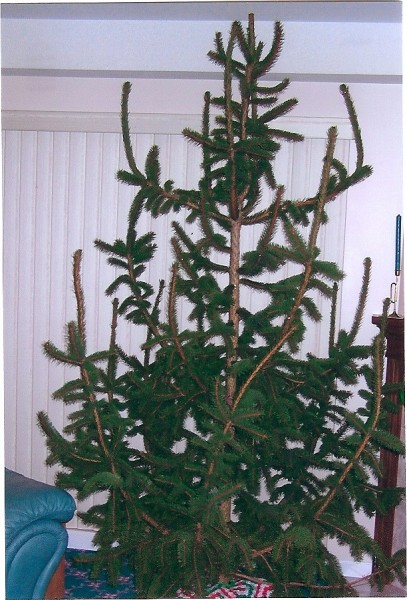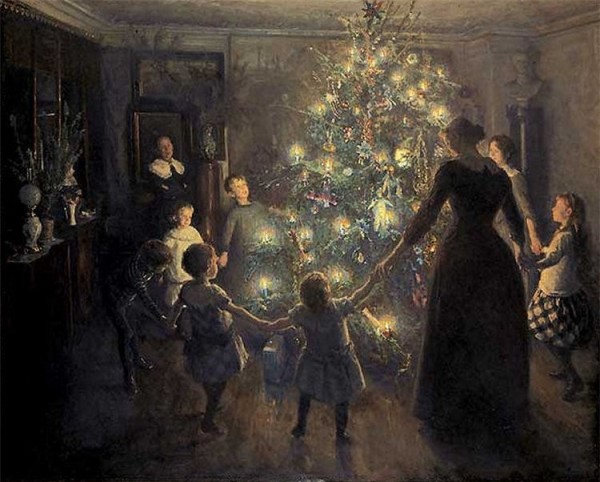On a terrifically windy day last August, I watched the trees rock and bounce as if shaken by giant hands.
Though still summer, the air whirled continuously with blown leaves. You’d think a few good blows would bring down all the loose ones—but no, they kept coming and coming. I don’t know how the trees stood it. Some didn’t. Now and then I’d hear a crack, a real explosion, as life erupted from a trunk or a hefty limb.
I thought back to a similar storm in early December of 2005, when the wind blew a beautiful Christmas tree right into our backyard—on the very day when I’d planned to go out and cut one! It was the top of a tall mugo pine from our boulevard, whose gangly strangeness made it my favorite Christmas tree ever.
The tree, I confess, is my favorite part of Christmas. I love trees anyway, and the chance to bring one into the house is thrilling. Throughout the season I love taking a few minutes each day just to sit in contemplation of Tannenbaum’s quiet splendor.
But does the custom of the Christmas tree have any biblical warrant? Not according to some commentators, who view it as a pagan practice. Some even quote Jeremiah 10:2-5:
Learn not the way of the nations …
for the customs of the peoples are vanity.
A tree from the forest is cut down
and worked with an axe by the hands of a craftsman.
They decorate it with silver and gold;
they fasten it with hammer and nails
so that it cannot move.
Their idols are like scarecrows in a cucumber field. (ESV)
Of course Jeremiah’s warning is directed against the worship of a manmade wooden idol. However, people don’t worship Christmas trees—although an argument can certainly be made that the commercialization of Christmas is a form of idolatry. But the tree, surely, is merely a symbol, a beautiful tradition pointing to a higher beauty.
But again: Is there any biblical support for this custom? I didn’t suppose so until that windy day in August. Though it was ludicrously early to be thinking of Christmas, I had to begin developing a marketing plan for my new book, Twenty-One Candles: Stories for Christmas. Part of the plan would be a series of guest blog posts. Only trouble was, it’s hard to get inspired about Christmas in August.
Ezekiel to the rescue!
Huh? Who thinks of Ezekiel, the gloom and doom prophet, in connection with Christmas? But that very morning I’d happened to read Ezekiel 17, when I came upon these verses:
Thus says the Lord GOD: “I myself will take a sprig from the lofty top of the cedar and will set it out. I will break off from the topmost of its young twigs a tender one, and I myself will plant it on a high and lofty mountain. On the mountain height of Israel will I plant it, that it may bear branches and produce fruit and become a noble cedar. And under it will dwell every kind of bird; in the shade of its branches birds of every sort will nest. (Ez 17:22-3 ESV)
Do you see the Christmas tree in this passage? I see it in the “noble cedar” whose branches are full of colorful birds reminiscent of decorations. Just like our windfall of 2005, the Lord takes the very tipmost top of a lofty cedar and transplants it to a conspicuous place, where it becomes a symbol of Christ—a tender shoot from God’s own “family tree,” the sacred lineage extending through Abraham and David all the way to Mary.
There is even a hint here of Good Friday with its other sort of tree: the bountifully fruitful cross of Calvary. The passage concludes poignantly with verse 24:
Then all the trees of the field shall know that I am the LORD; I bring low the high tree, and make high the low tree, dry up the green tree, and make the dry tree flourish. I am the LORD; I have spoken, and I will do it. (ESV)
At Christmas, God cut the top from a tree so lofty that it reached all the way to heaven, and He brought it down to earth. Why? In order that all the lower trees might be exalted. And why was this celestial green tree bled of its sap and dried out in death? In order that all the dead trees of this world might be regenerated with new life.
Yes, I believe we certainly have biblical support for the custom of Christmas trees. Listen to what the Lord says in Hosea 14:8: “I am like a green pine tree; your fruitfulness comes from Me.” Or consider Jeremiah 23:5:
“The days are coming,” declares the Lord,
when I will raise up to David a righteous Branch,
a King who will reign wisely
and do what is just and right in the land.” (NIV)
Indeed I see Christ-like trees all the way through scripture, from the two trees in the Garden of Eden, to the ever-bearing trees of life lining the great river in heaven, whose “leaves are for the healing of the nations” (Rev 22:2). No wonder the Christmas tree in our living room has such a presence of peace, beauty, and wonder. Is it not God Himself who has established this custom to glorify His Christ?
O Christmas tree! O Christmas tree!
How lovely are thy branches!
Next Week: Christmas Adam
(The book-in-progress, Jesus: His Story In Stone, will resume on January 6)


